
44 Days Paid Time Off for the Average Federal Employee Costs Taxpayers an Estimated $24 Billion | July 5, 2021
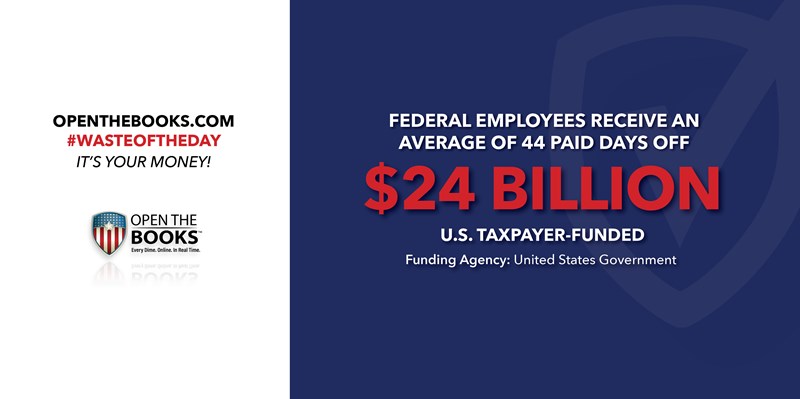
Is this France? With the addition of Juneteenth, federal employees now have an average of 44 days off every year. That is almost nine full weeks of paid time off!
President Joe Biden gave millions of federal employees the day off this year to celebrate the new federal holiday, which marks June 19 as a day to commemorate the end of slavery in the United States.
The federal government employs approximately 2.1 million civilian employees, plus 1.3 million active-duty military personnel and around 500,000 postal service employees.
Before Juneteenth was made a federal holiday, federal employees received pay for 10 federal holidays, 13 sick days and 20 vacation days per year on average.
Auditors at OpenTheBooks.com estimate these benefits cost taxpayers $24 billion annually. Adding the new 11th federal holiday increases that figure.
Congress is also trying to get federal workers another day off for Election Day, with H.R. 1 already passed by the House, and the Senate yet to vote.
That bill would add Election Day as a new paid holiday every two years for congressional and presidential election years. It would also require states to have early voting and no-excuse absentee ballot voting, which would seem to negate the need for a day off.
Where does it end?
Taxpayers Fund Alligator Studies for $725,265 – Sleep, Eat, and Nest | July 6, 2021
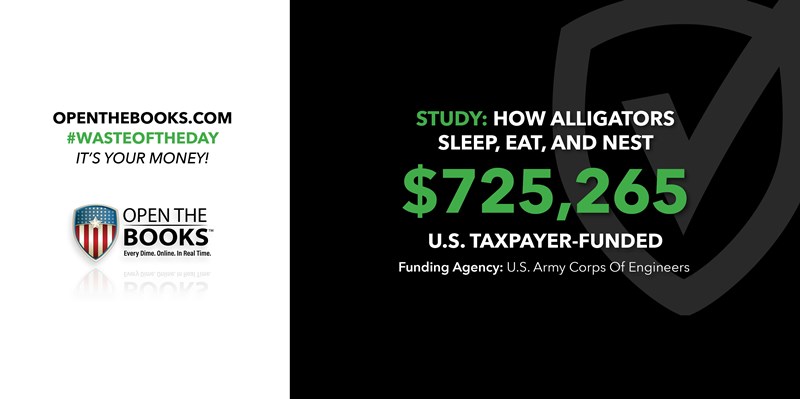
If you have ever wondered about an alligator’s sleeping, eating, and nesting habits, a new project monitoring those in the Florida Everglades may whet your appetite.
The U.S. Army Corps of Engineers is giving researchers $145,053 this year to study the scaly creatures and up to $725,265 for the duration of the project.
The grant offering says that monitoring the status of alligators is important because the reptiles are an ecological indicator of how the Everglades are holding up.
“The Florida Everglades is the only place in the world where both alligators and crocodiles occur,” the grant summary says. They “are indicators of ecosystem health and restoration success, because at all life history stages, crocodilians integrate biological impacts of hydrologic conditions.”
These predators are dependent on prey density, so their status provides a surrogate for the status of many other species, the grant says.
Dry nests and wet trails and holes are conditions created by “ecosystem engineers” like alligators, providing habitats for plants and animals that otherwise could not survive, the grant states.
The study will collect data and help form an understanding of the alligator population and their body conditions, including looking at their long-term patterns of nesting.
However, the biggest thing gobbled up in this study is taxpayer dollars – nearly three-quarters of $1 million!
Federal “Infrastructure” Subsidies for the Bigger Boats Costs Taxpayers $14 Million | July 7, 2021
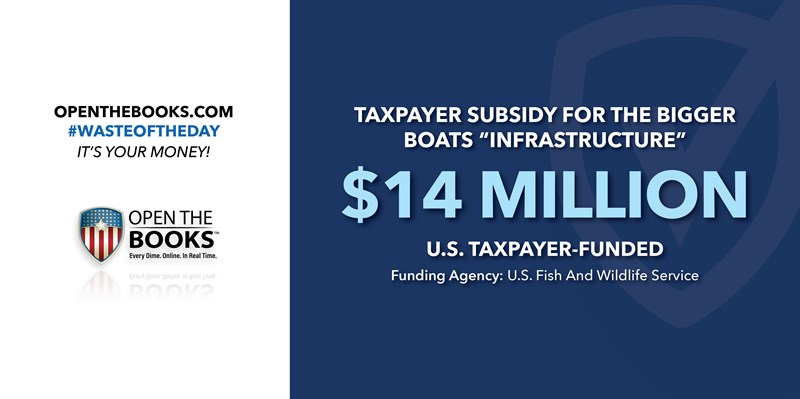
What better way to enjoy a warm summer day than on your boat with your family and friends, catching some fish and some sun, feeling the light breeze against your face.
Oh, you don’t have a boat?
Well, that’s too bad because the U.S. Fish and Wildlife Service is giving $14 million to states to spiff up their infrastructure for recreational boaters.
But your boat must be 26-feet, or bigger.
The funds will pay for the construction, renovation and maintenance of boating infrastructure facilities for recreational boats that are 26 feet long or longer.
“Recreational boating is a popular activity; there are approximately 11.8 million registered motor boats in the United States. Of this total, an estimated 584,000 are at least 26 feet long,” the grant summary states.
This grant helps those boaters in the top 5%. Maybe they do not need taxpayer help if they own a boat that big?
The $14 million will be spent on structures, equipment, accessories and services that a facility uses to accommodate transient vessels — those passing through a place, i.e. staying up to 15 days.
The projects that use the funds must provide public access, but can be publicly or privately owned, the grant summary says.
What better way to spend $14 million in taxpayer money than to help bigger boat owners have a beautiful day on the water?
Taxpayer Funded “Hipster Parties” Cost $5 Million – Quit Smoking, Get Cash | July 8, 2021
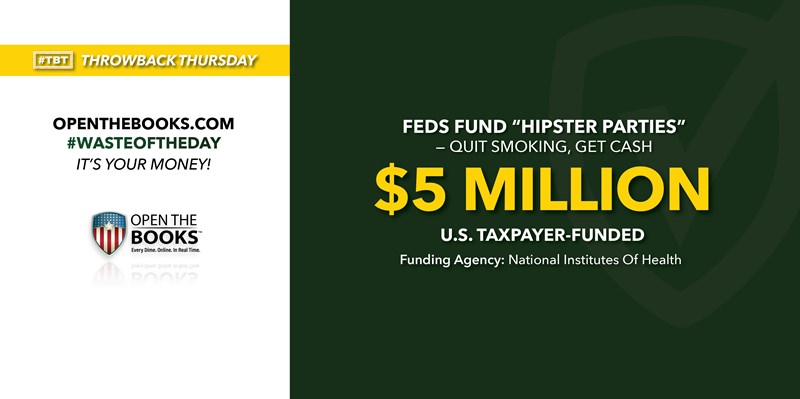
Throwback Thursday!
We all know that smoking is bad for you, but the feds spent $5 million over five years to reiterate that message through “hipster parties.”
The project to “Help A Hipster” quit smoking got the funding from the National Institutes of Health (NIH) – to organize parties.
The parties for hipsters took place at bars and nightclubs, hoping to entice them to "take a stand against tobacco corporations."
Giving away cash was the backup plan. When the main program failed to get people to quit smoking, the participants received up to a $100 “Quit smoking, get cash” payment.
Here’s how the report described giving away the money: when the "parties fail to achieve that goal, the intervention gets blunt, flashing cash in front of the hipsters 'stache.”
To summarize: the NIH, a leading medical research agency, gave the grant for $5 million. The grant was not used for any research or real medical purpose. It was funneled into a marketing campaign that blamed tobacco companies for people’s smoking habits.
This message was delivered at hipster parties.
Feds Pay PepsiCo $5 Million to “Engage Women Farmers” Overseas
| July 9, 2021
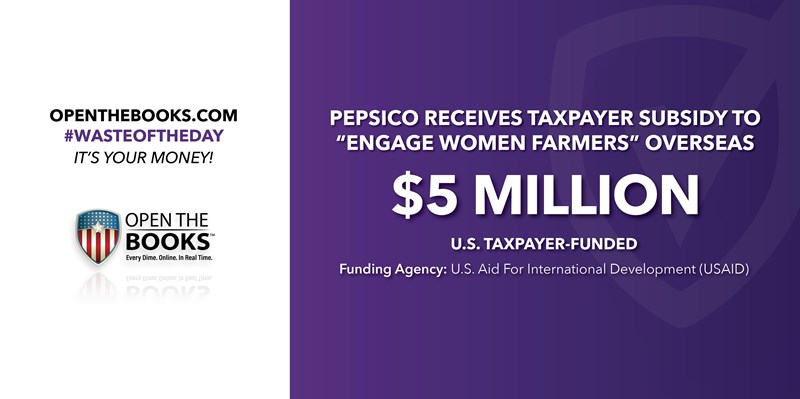
While agriculture is an important industry in the U.S., providing jobs to millions and food for many, many more millions, should multinational for-profit corporations get federal tax dollars for social welfare experiments?
The U.S. Agency for International Development (USAID) thinks so.
It is giving away $5 million between 2020 and 2025 so that PepsiCo can change its business approach to working with female farmers.
That is the New York-based food, snack, and beverage corporation with brand names including Tropicana, Quaker, Lipton, Pepsi, Gatorade, and Doritos, with annual revenues of more than $70 billion.
Ranked by profits, PepsiCo is the 43rd most profitable large company in the U.S., according to Fortune.
The USAID Global Development Alliance — or GDA — partners with the private sector, in this case, PepsiCo, to find market-based approaches to solve development challenges.
Here, the GDA plans to “develop and demonstrate the business case for private sector investments in women’s economic empowerment, particularly focused on changing PepsiCo’s core business approach to engaging with farming communities,” the grant summary states.
“Starting with agriculture, the partnership intends to realize women’s gains from participation and showcase the benefits for both women and communities, when a company engages more intentionally on gender within their existing agricultural supply chains.”
That is the long way of saying taxpayer dollars are going to a for-profit corporation – and one of the richest in the world.
The #WasteOfTheDay is presented by the forensic auditors at OpenTheBooks.com.